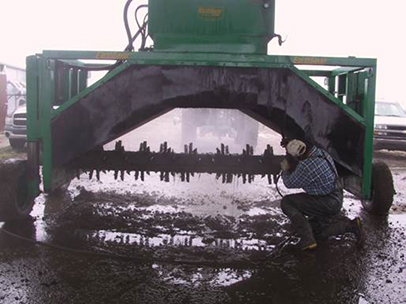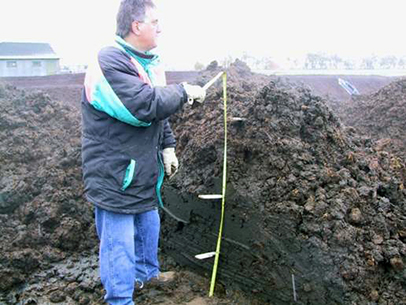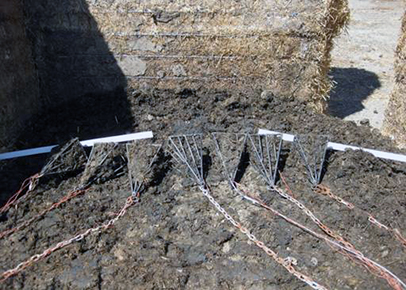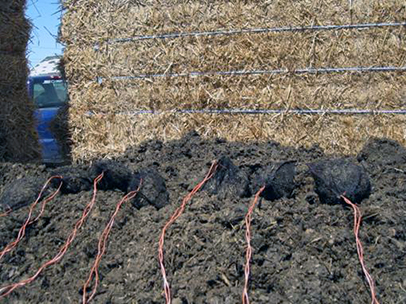Many farmers refer to manure as “black gold” and rightly so because it adds nutrients to the soil, which helps crops grow and be more productive.
In earlier times, before the advent of synthetic fertilizers, crop farmers would often buy a cow solely for the manure it would produce and use the manure for fertilizer. In modern times, many farmers still rely on manure — oftentimes raw manure — to improve their soil and boost productivity.
But the question arises: With the widespread use of antibiotics in animal agriculture, are these antibiotics getting into our food through the manure spread on cropland, or even through irrigation water?

And what about antibiotic resistance, which experts from the World Health Organization (WHO), along with the Centers for Disease Control and Prevention (CDC) and the World Economic Forum, say is one of the top public health threats in the world?
Antibiotic resistance occurs when antibiotics, both in animals and humans, stop working when they are used in ways that make bacteria resistant to them. In agriculture, that can include the use of sub-therapeutic doses of antibiotics over long periods of time — in animal feed, for example.
According to CDC, all animals carry bacteria in their intestines. Giving antibiotics to animals will kill most bacteria, but resistant bacteria can survive and multiply. When food animals are slaughtered and processed, these bacteria can contaminate the meat or other animal products.
Also troubling, says CDC, these resistant bacteria can also get into the environment through the manure and may spread to produce irrigated with contaminated water.
The agency also points out that Salmonella and Campylobacter, two of the many bacteria commonly transmitted through food, cause an estimated 410,000 antibiotic-resistant infections in the U.S. each year.
While concerns about this hotly disputed issue center on the meat we eat and the milk we drink, what about our vegetables and fruits, even those that are organic? And what about time? Do antibiotics in the manure, or compost, die off after a certain amount of time?

Another question: Does composting, which kills foodborne pathogens (when properly done), destroy the antibiotics in the manure?
No easy answers
There are no easy answers to questions like these, as can be seen in how the final Produce Rule in the Food Safety Modernization Act treats the subject. While the proposed rule called for a minimum time interval of nine months before raw manure (or untreated biological soil amendments of animal origin) could be applied to soil, the U.S. Food and Drug Administration’s final rule removed that nine-month interval and deferred its decision until more research can be done.
Instead, the agency states that “it won’t take exception to farmers” who comply with USDA’s National Organic Program standards. Those standards call for a 120-day interval between the time of applying raw manure for crops having edible parts in actual contact with soil (carrots and potatoes, for example) and 90 days for crops with edible parts not in actual contact with soil (beans, corn and peas, for example.).
As for compost (including composted manure), the agency has concluded that, from a public health standpoint, properly treated and handled compost is safer than raw manure. For that reason, FDA plans to eliminate the previous 45-day minimum application for properly treated and handled compost.
About those antibiotics
For the past 50 years, farmers have fed antibiotics to animals such as cattle, pigs and chickens not only to treat them when they’re sick but also to promote growth and ward off infections, some of which are caused or aggravated by crowded living conditions.

Overall, this adds up to a lot of antibiotics. According to the Union of Concerned Scientists, 70 percent of all antibiotics and related drugs used in the U.S. are fed to cattle, pigs and poultry.
The problem with that, according to some researchers, is that up to 75 percent of these antibiotics are not completely absorbed by the animals, which means out they go in the manure.
According to one report, “Antibiotic Uptake by Plants from Soil Fertilized with Animal Manure,” published in 2005 in the Journal of Environmental Quality, USDA in 1997 estimated that more than 8 billion animals (95 percent of them turkeys and chickens) were producing billions of pounds of manure in the U.S.
“These numbers,” stated the report, “would suggest that the presence and persistence of antibiotics in this large quantity of manure presents a significant environmental problem, both in terms of toxicity of these antibiotics to soil microflora and fauna as well as potentially increasing antibiotic resistance in the environment.”
Another group of researchers cited in the report went even further and stated that, “land application of antibiotic-laced manure appears to be the dominating pathway for the release of antibiotics in the terrestrial environment.”
Yet, as the report pointed out, there are no guidelines governing the presence of antibiotics and hormones in manure.
Research done on green onions, cabbage and corn grown in greenhouses with antibiotic-laden manure came up with still more questions. In some cases, some plants did contain traces of one antibiotic (a form of tetracylines) but not another (Tylosin). According to the report’s conclusion, “the adverse impacts of ingesting antibiotics present in plants by humans is not known at this stage.”
Even so, the report stated that antibiotics in plant materials eaten by humans may lead to resistance to human pathogens, and that, in turn, could lead to illnesses that may be difficult to cure with presently available antibiotics (in other words, antibiotic resistance).
This clear warning is at the end of the report’s conclusion: “There is an urgent need to study the fate of different antibiotics present in manure as well as which antibiotics and their degradation products may be taken up by plants grown on soils where manure has been applied.”
In human terms, noted the conclusion, it’s important to know whether or not antibiotics in food degrade when cooked. And when considering human health, it important to study “whether or not antibiotics, or their degradation products, remain bioactive” and are therefore capable of causing antibiotic resistance or immunological reactions in humans.
More about those vegetables
In an article published in Scientific American, “Worried about Antibiotics in Your Beef? Vegetables May Be No Better,” researchers explored the possibility that antibiotics can end up in the vegetables we eat. But again, the conclusion was that many questions remain unanswered. The good news, though, was that the heat generated by composting did reduce concentrations of some antibiotics by up to 99 percent.

According to the article, researchers wanted to find out which antibiotics are more likely to be picked up by the plants and which plants are more prone to taking up antibiotics. In addition, they wanted to determine which methods of composting are the most effective in reducing harmful materials (such as antibiotics) in manure and which antibiotics may be resistant to composting.
Then, too, manure containing antibiotics affects more than just the soil, according to the article. Once put on the land, antibiotics can seep through the soil into aquifers or into surface water when spills occur. And some of that water is used for irrigation.
“We need a better understanding of what takes place when chemicals are applied to sources of food and must be more vigilant about regulating what we use to grow food and what we put in our bodies,” Satish Gupta, a University of Minnesota professor of soil science, told Environmental Health News.
And this from CDC: “Antibiotics must be used judiciously in humans and animals because both uses contribute to not only the emergence, but also the persistence and spread of antibiotic-resistant bacteria.”
Although many large-scale U.S. livestock farms have to abide by regulations to prevent manure from getting into waterways, that still leaves the question about manure that can be used for fertilizer. Can pathogens and antibiotics that might be in the manure be taken up by the crops?
Research has shown that many plants actually have a barrier that stops pathogens from going past their roots and into the plants, although more research is being done on this. The verdict for now is that the likely route for contamination occurs after the plants are harvested through improper handling and cross-contamination with tainted vegetables, fruits, or even meat.

Chad Kinney, chemistry professor at Colorado State University-Pueblo, told Food Safety News that his research on biosolids and reuse of wastewater found that in controlled greenhouse trials, they found that sulfamethoxazole, an antibiotic, can accumulate in cabbage tissue.
However, one of the students working on the project calculated that a person would have to consume thousands of pounds of cabbage to get one therapeutic dose.
“But the potential for uptake is there,” Kinney noted.
What about managing all that manure?
In a recent article, “Mooving manure beyond drug resistance,” provided by the staff at the Journal of Environmental Quality, Tim McAllister, a Canadian scientist who does research in ruminant microbiology and nutrition, said he has been working with colleagues to target antimicrobial resistance genes in manure.
He noted that not all bacteria are bad and that the trick is finding which ones become resistant to antibiotics and whether or not those that do will affect human health.
“When you use antibiotics, bacterial resistance is inevitable,” he said in the article. “There’s always trade-offs in nature. It really is a matter of which bacteria become resistant and if it has any implications for human health.”
But he also stated that most bacteria that could cause human infections don’t do all that well in the broader environment.
As for surviving in high temperatures such as occur in composting, McAllister said that most bacteria die after being exposed to temperatures above 131 degrees F or higher over a period of a few days, which can happen during composting.
Researchers want to figure out the most reliable way to kill bacteria and degrade the DNA associated with antibiotic resistance, he said.

Looking to the future, McAllister said experiments could be designed to observe “the journey of bacteria from farm to the surrounding environment” to discover where resistant bacteria end up if they haven’t been destroyed by composting or manure stockpiling.
“The concentration of bacteria is the issue — and if those concentrations travel,” he said.
Describing the journey for most bacteria from animals to people as a “tough one,” McAllister noted that most don’t make it.
“Manure management practices such as composting and stockpiling can make this journey for bacteria even more difficult,” he said, adding that finding solutions calls for “a host of scientists and a lot of grant writing.”
(To sign up for a free subscription to Food Safety News, click here.)
